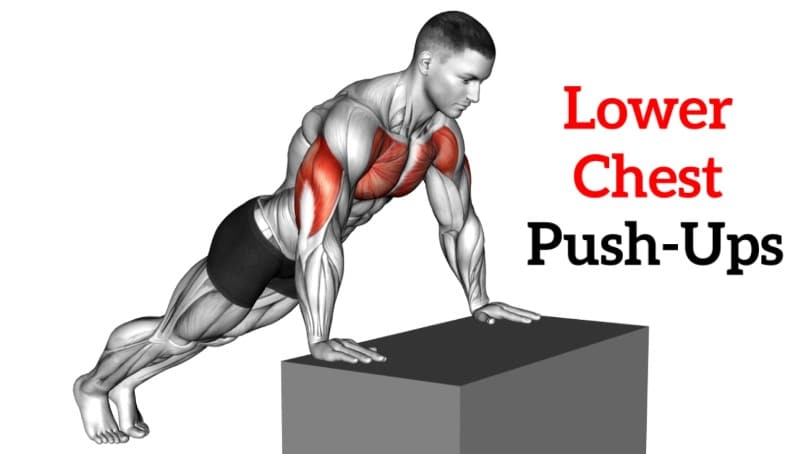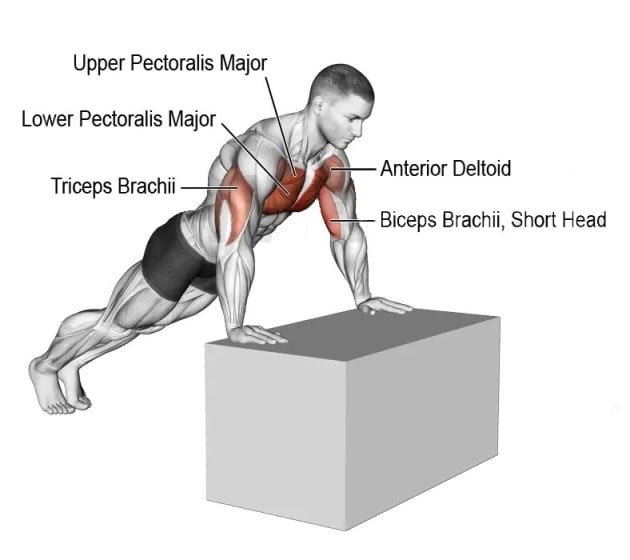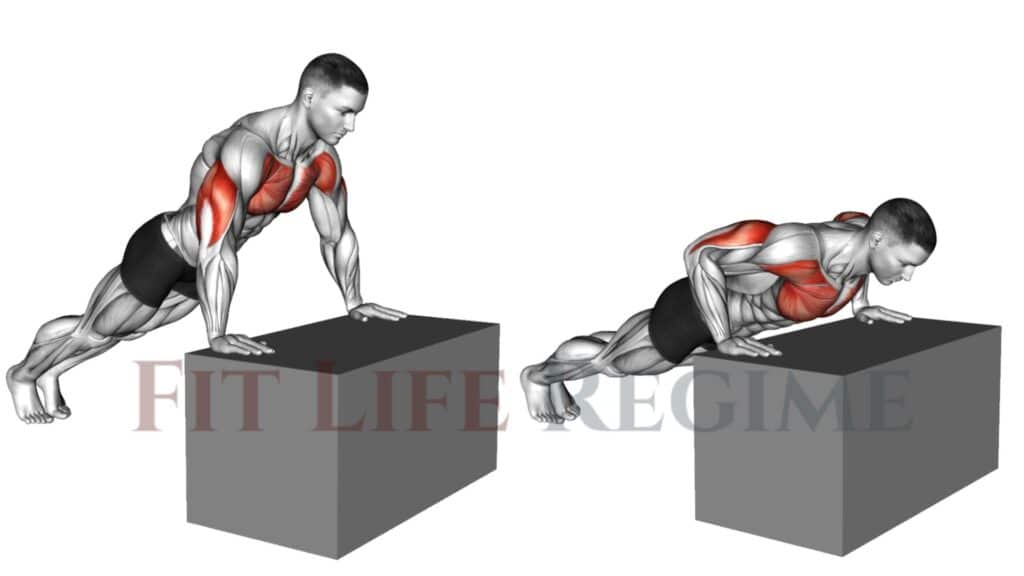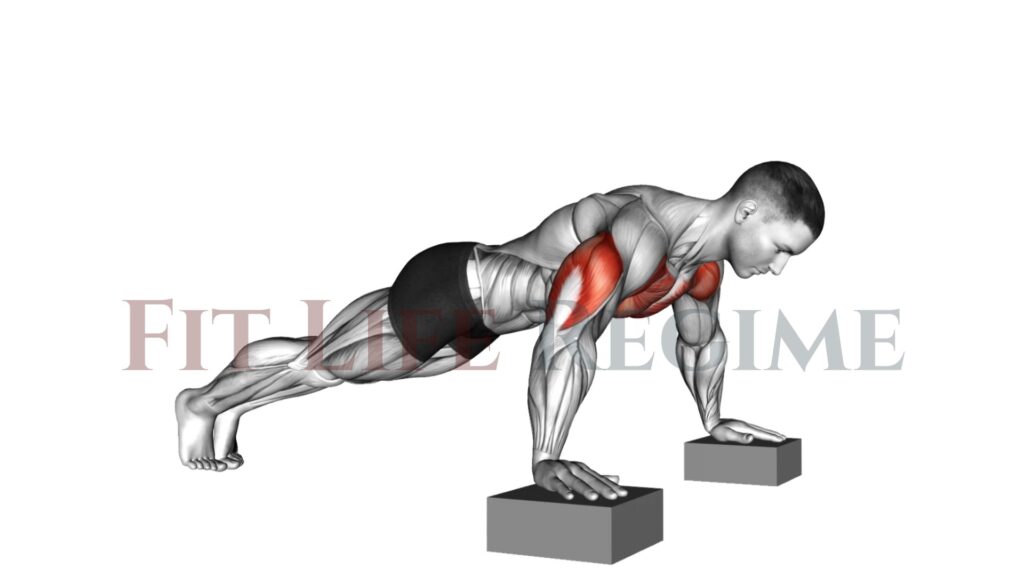If you are looking for push-ups that work the lower chest, you’ve come to the right place. Here, we’ll talk about the best push-up for training the lower pec.
You can strengthen and increase the thickness of your lower pecs by including this lower chest push up into your training regime. Having a well-developed lower chest helps to create a fuller upper body, and also has functional benefits.
When we talk about chest muscles, it’s important to note that there are two main sections, upper and lower pecs. To achieve the greatest muscle thickness and strength, you should develop the muscle from all angles.
Specific workouts, like lower chest push-ups, work on specific muscles and make you look better. You need to focus on exercises that will create a defined muscle in the lower or sternal portion of the chest, in order to build the lower chest.

- What is Lower Chest Push ups
- How To Build Lower Chest With Push Ups
- Muscles Worked by Lower Chest Push Ups
- Benefits Of Lower Chest Push Ups
- 7 Best Push-ups That Work Lower Chest
- 1. Incline Push-Up On Box
- 2. Elevated Push-up
- 3. Reverse Grip Push-Ups
- 4. Hindu Push-Up
- 5. Clapping Push Up
- 6. Close Grip Medicine Ball Push-Up
- 7. Stability Ball Push Up
- People Also Asked
- Do incline push ups work lower chest
- Which push-ups work lower chest?
- How Can I Work Out My Lower Chest With Push Up?
- Takeaway
- Know More About Chest Training
- Pushups For Lower Chest You Can Easily Do At Home
What is Lower Chest Push ups
Lower chest push-ups are a variation of the standard push-up that emphasizes the lower portion of the pectoralis major muscle.
Unlike conventional push-ups, which target the entire chest area, lower chest push-ups place greater emphasis on the lower pectoral muscles by altering the body positioning.
To do a lower chest push-up, you will need to elevate your upper body by placing your hands on a raised surface such as a bench, step, or even a wall. This will shift the angle of the push-up and put more emphasis on the lower chest muscles.
The lower chest push-up is an excellent exercise option for beginners, individuals with limited mobility, or those recovering from injury. This push-up variation reduces the amount of weight placed on the upper body compared to a standard push-up.

How To Build Lower Chest With Push Ups
Many people choose to build muscle with push-ups because they have many benefits. When it comes to resistance, your body reacts to any kind of resistance, whether you are using weights, a bottle of water, or your own body.
Choosing the right exercises, with the right intensity, allows you to eliminate the need for weights from your lower chest workout routine.
Start with incline push-ups. Push-ups done with your hands on a bench, step, or other surface put the emphasis on your lower chest muscles.
To enhance muscle growth, it is recommended to gradually overload your muscles by increasing the number of reps, sets, or resistance over time.
Muscles Worked by Lower Chest Push Ups
Lower chest push-ups predominantly target the lower section of the pectoralis major, the chief muscle of the chest.
In addition to the pectorals, several other muscles are engaged. The anterior deltoid, assists in the downward and upward motion of the push-up. The triceps brachii, works to extend the elbow during the rising phase.
Another significant muscle is the serratus anterior, which lies on the side of the chest and is activated as the shoulder blades move.
Lastly, core muscles play a pivotal role in maintaining stability and form. This includes the rectus abdominis, commonly known as the “six-pack” muscle; the obliques, and the transverse abdominis, a deeper muscle providing core stability.
In essence, while lower chest push-ups focus on the chest’s lower region, they offer a holistic workout for the upper body.

Benefits Of Lower Chest Push Ups
When it comes to training, the lower pecs, bodyweight push-ups exercises are a perfect choice because:
- Lower chest push-ups will improve muscular endurance within the upper body, strengthen both muscles and bones.
- It will boost your explosiveness. Don’t believe me? Wait until you’ve worked your plyo push-ups to the flying progressions, and you’ll see what I mean!
- A push-ups workout for the lower chest requires more balance and can lead to more muscle fiber being used.
- Doing chest push-ups can be a powerful full-body workout and help to burn more calories.
- As you’ll be moving your full body around, these drills will improve your metabolism, get you to burn more fat and help you achieve that mean and lean look.
- Push-ups are also considered a compound exercise because they require multiple muscle groups to be worked simultaneously. One benefit of push-ups is that they can also enhance the cardiovascular system by making your heart work harder.
- One of the lesser-known push up benefits for men is that they can increase testosterone production in men.
- Are you looking to build a home gym? You don’t need any special equipment to practice the push-ups workout. All you need is the right technique and some willpower.
7 Best Push-ups That Work Lower Chest
Here are the best lower chest pushes that require no equipment, or just a slight modification to target your lower pecs. With so many variations of push-ups available, one type will help you develop the lower portion of your chest better than others.
You might feel like the exercise that uses a stability ball or medicine ball is the one that puts your lower chest further forward, as it seems that your lower chest is on fire as you press up and down.
1. Incline Push-Up On Box
The incline push up is a great bodyweight exercise that you can do to build your chest. It offers numerous benefits and is perfectly suited for both beginners and experienced athletes looking to build upper body strength.
The incline push up is a variation of the push-up where you push yourself off from a raised object instead of the ground.
You can also use objects like a chair, a gym bench, a sofa, a box, a sturdy table, or anything else.

How To Do Incline Push-Up On Box
- Stand approximately 3 to 3.5 feet away from a low bench or sturdy chair.
- Reach forward and grab the sides of the chair or in front of the bench, keeping the balls of your feet in contact with the ground.
- Slowly lower yourself by flexing your elbows so that your chest comes within a few inches of the edge of the chair or bench.
- Using your hands, push yourself back to the starting position while focusing on maintaining a straight body position from head to ankle.
- The movement should be smooth and controlled.
Training Tips
- Be sure the bench or chair is stable and secure before you perform the push-ups.
- Your back and legs should be straight at all times.
2. Elevated Push-up
With the elevated push-up, the higher you are, the easier the push-up, while the lower you are, the more challenging it is. This move will work the chest, shoulder, and triceps, and the slight incline will put more work on the lower chest than standard push-ups.
Push-ups can be performed with a multitude of variations to bring about different muscular recruitment patterns. Performing push-ups at an incline angle will put more focus on the lower chest.

How To Do Elevated Push-Ups
- Put the hands, shoulder-width apart, on the bricks.
- Adopt an incline plank position by extending the legs backward until the legs and back form a straight line.
- Slowly bend the arms to lower the chest toward the bench. Remember to keep the elbows and arms close to the body.
- Slowly push the body away from the bench, extending the arms but maintaining a slight bend in the elbow.
- Perform 8–12 reps for one set.
Training Tips
- Exhale while you exert.
- Stand at a comfortable distance from the bench.
3. Reverse Grip Push-Ups
The reverse grip push-up is a fun and great variation of the standard push-up. The exercise is done with your fingers facing your feet (your palms outward).
These push-ups require your hands to be closer to the hips beneath the lower chest level. This makes your lower chest, as well as front shoulders, work extra hard during the movement.

How To Do Reverse Grip Push-Ups
- Get down into a press-up position with your hands placed, so your fingers are pointing towards your toes.
- Take a big breath in and slowly start to bend your elbows.
- Do not let your elbows move outwards (away from your body).
- Lower yourself until you are about an inch from the floor. Pause the movement when you are at the bottom for a second.
- Push through your palms like you would try to push the floor away from yourself, extending the arms but maintaining a slight bend in the elbow.
- Repeat this for however many repetitions you wish to perform.
Training Tips
- Always make sure to do a proper warm up especially focusing on warming up and stretching your wrists
- Keep your neck in a neutral position to avoid stressing and hurting it.
- When you lower yourself, take it slow and easy, and really push yourself back up.
4. Hindu Push-Up
The Hindu push up is a traditional Indian-style exercise practised by wrestlers. Each repetition includes going from a downward dog position to a cobra pose, swooping by holding the head and body close to the ground.
The arms would be straight at the beginning and the end of the exercise. This variety of push-ups has existed for centuries among Indian martial artists. It works on core strength, shoulders, hips, and triceps.

How To Do Hindu Push-Up
- Start in a downward dog pose, with your hands shoulder-width apart, your body in a V shape, and your feet hip-width apart.
- Bend your elbows and lower your chest until it’s just above the floor, going into low plank pose.
- In a scooping motion, scoop your head upward while arching your lower and upper back and go into cobra pose.
- To return to the starting position, you do not need to reverse back through the sweeping, arching motion. Simply push back into the starting position.
Training Tips
- Engage your core, relax the spine and neck, open the shoulders and keep the movement smooth.
- Remember to breathe correctly as you do the push-ups.
5. Clapping Push Up
Clapping push-ups are an advanced type of push-up that works your chest, triceps, abs, and shoulders. They require a lot of strength and muscular endurance.
It can help you lose weight and build muscle. Many athletes use them to improve their athletic performance by building strength, endurance, and speed.

How To Do Clapping Push-Ups
- Start in a standard Push-Ups.
- Start to lower your body as if you’re going to do a push until your chest is almost touching the floor.
- Reverse the motion by pushing hard through the palms, just as your arms reach full extension, pull your hands up off the floor.
- Rapidly clapping the hands together and placing them back in the original position before your body falls back to the ground.
Training Tips
- Be sure to exhale when exploding off the ground and inhaling on the way down.
- Do not let the elbows flare out. Keep the elbows close to your sides throughout.
- Keep the core tight and back flat throughout the movement.
6. Close Grip Medicine Ball Push-Up
The close-grip medicine ball push-up is a strength exercise that works the chest and shoulders, with a little more focus on the triceps. The instability of the ball improves core strength and stability.
Doing push-ups with your knees bent on the floor or placing a medicine ball on a higher platform can both reduce resistance. You can substitute a brick for a medicine ball.

How To Do Medicine Ball Push-Up
- Get in the standard push-up position with your hands on a medicine ball directly beneath your chest.
- Your left thumb and forefinger should touch your right thumb and forefinger.
- Bend your elbows to lower yourself in a controlled manner.
- Maintain a rigid core as your chest moves towards the top of the ball.
- Hold for one to two seconds before breathing out, extending your arms and pushing your body back to the starting position.
- Repeat the desired number of repetitions.
Training Tips
- Balance should be maintained during both phases.
- Your elbow should be tucked at your sides.
7. Stability Ball Push Up
Using a stability ball can make push-ups more difficult by giving you an uneven surface to work with. This is a great exercise for working the lower part of the chest.
You will have to work harder to maintain your balance on the ball, which will make the move more challenging than the standard, floor-based version.

How To Do Stability Ball Push Up
- Lay with your chest on the stability ball. Place your hands on the ball at the sides of your chest. They will be shoulder-width apart.
- Place feet back and lean forward so that your chest is directly over the ball, and you are supported on your toes.
- Push your body up, until your arms are almost straight (do not lock your elbows). Pause here for a second.
- Breathe out and extend your arms to bring your upper body back to the starting position.
- Repeat for the desired number of repetitions.
Training Tips
- Do not let your lower back sag or your butt rise. Ensure your body is straight and rigid.
- Keep your glutes and core muscles contracted.
- Your neck should be in line with your body, not tilted up, which could strain the neck.
People Also Asked
Do incline push ups work lower chest
Incline Push Ups are the best exercises for training the lower chest.
Which push-ups work lower chest?
The incline push up is one of the best pushups for the lower chest. You will be expected to incline at a certain angle in order to complete this move. The inclination is what helps target the lower chest muscles.
How Can I Work Out My Lower Chest With Push Up?
There are several different push up variations that you can do anywhere. It is important to note that you will need to modify the exercises when you do them at home. However, you can get a good workout without expensive fitness equipment.
Instead of push-ups on a gym bench, you could use chairs or any other elevated surface. You could also do incline push-ups on a sofa or chair.
Once you learn how to make basic changes, you can start to be more creative.
Takeaway
It can be difficult to train parts of the body that are particularly stubborn, but with persistence, the right methods, and slight modifications to push-ups exercises, you might be able to make a positive change.
The push-ups above will work the lower chest when a person performs them correctly. It is best to add these exercises to a full-body strength training routine to achieve a well-balanced physique.
To build a strong upper body, it’s important to train the chest as a whole unit and then focus on getting all 3 parts of the muscle working.
Know More About Chest Training
- Upper Chest Bodyweight Workout That You Can Do at Home
- 15 Bodyweight Triceps Exercises: Beginner to Advanced
- Best Tricep Workout At Home Without Equipment For Bigger Arms
- Upper Chest Cable Exercises for Bigger & Stronger Chest
- Incline Chest Fly: Benefits, Muscles Worked, Form
Pushups For Lower Chest You Can Easily Do At Home

Manish brings over 10 years of hands-on experience in weight lifting and fat loss to fitness coaching. He specializes in gym-based training and has a lot of knowledge about exercise, lifting technique, biomechanics, and more.
Through “Fit Life Regime,” he generously shares the insights he’s gained over a decade in the field. His goal is to equip others with the knowledge to start their own fitness journey.
